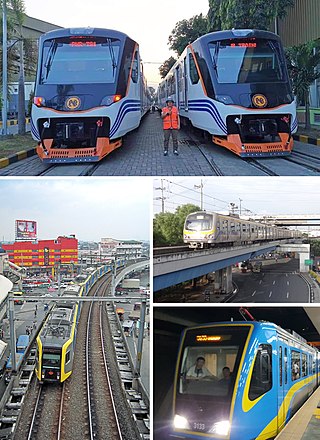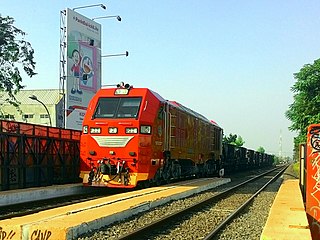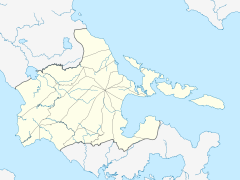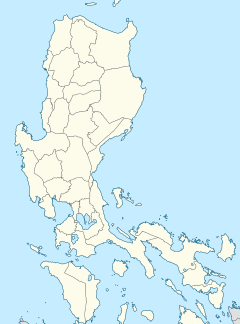
The Philippine National Railways (PNR) is a state-owned railway company in the Philippines which operates one commuter rail service between Laguna and Quezon, and local services between Sipocot, Naga and Legazpi in the Bicol Region. It is an attached agency of the Department of Transportation.

Rail transportation in the Philippines is currently used mostly to transport passengers within Metro Manila and provinces of Laguna and Quezon, as well as a commuter service in the Bicol Region. Freight transport services once operated in the country, but these services were halted. However, there are plans to restore old freight services and build new lines. From a peak of 1,100 kilometers (680 mi), the country currently has a railway footprint of 533.14 kilometers (331.28 mi), of which only 129.85 kilometers (80.69 mi) are operational as of 2024, including all the urban rail lines. World War II, natural calamities, underspending, and neglect have all contributed to the decline of the Philippine railway network. In the 2019 Global Competitiveness Report, the Philippines has the lowest efficiency score among other Asian countries in terms of efficiency of train services, receiving a score of 2.4, and ranking 86th out of 101 countries globally. The government is currently expanding the railway network up to 1,900 kilometers (1,200 mi) by 2022 through numerous projects.

Sucat station is a railway station located on the South Main Line in Muntinlupa, Metro Manila, Philippines. It was originally established by the Manila Railway Company in 1908 as part of the construction of the original Southern Lines to the province of Tayabas, since renamed Quezon. It is also the southernmost area on the PNR Metro Commuter Line to be upgraded to double track as a result of a proposed electrification scheme in 1978.

Naga station is a railway station located on the South Main Line in Naga, Camarines Sur, Philippines. It is a major station on the line, serving as the main terminus for the Bicol Commuter, Bicol Express train services and the end station for the Isarog Limited Express. The station is considered the largest of all Philippine National Railways (PNR) stations in Southern Luzon. It houses the regional offices of PNR that covers the total jurisdiction over Southern Luzon.

Legazpi station is the current railway terminus of the South Main Line located in Albay, Philippines. It is also the terminus for the Legaspi-Tabaco branch line. The station is currently used for the Bicol Commuter rail.

The PNR 900 class is a class of 21 GE Universal Series diesel–electric locomotives operated by the Philippine National Railways since 1973. The locomotives comes with three different types: U14CP (1973), U14C (1979), and U15C (1991). Initially used for long-distance express services throughout Luzon, they were relegated to hauling commuter trains within Metro Manila, a task previously done by PNR's diesel multiple units fleet. This was further exacerbated by the closure of the PNR South Main Line's intercity section in 2012 after an accident in Sariaya, Quezon.

The PNR Metro Commuter Line was a commuter rail line operated by the Philippine National Railways. It was first inaugurated as the Metro Manila Commuter Service in 1970, and originally served the North Main Line and the South Main Lines, as well as the defunct Carmona and Guadalupe branch lines. Since then, it adopted several names such as Metrotrak and Metrotren, before adopting its present name in the late 2000s. The line was also nicknamed the Orange Line due to its designation in the 1970s.
Ragay station is a railway station located on the South Main Line in Camarines Sur, Philippines. It is still in use for the Bicol Express and Isarog Limited.
Sipocot station is a railway station located on the South Main Line in Camarines Sur, Philippines. It is still used for the Bicol Express and Isarog Limited.

Libmanan station is a railway station located on the South Main Line in Camarines Sur, Philippines. It is still use for the Bicol Express and Isarog Limited.

Pamplona station is a railway station located in the South Main Line at Pamplona, Camarines Sur, Philippines. It is one of the stops of the Bicol Express and Isarog Limited Express trains until the suspension of the intercity trips. The station is currently in use for the Bicol Commuter Train.
Polangui station is a railway station located on the South Main Line in Albay, Philippines. It is still used for the Bicol Commuter.
Pili station is a railway station located on the South Main Line in Camarines Sur, Philippines. It is still used for the Bicol Commuter.

Daraga station is a railway station located on the South Main Line in Albay, Philippines.

The PNR South Main Line is one of the two trunk lines that form the Philippine National Railways' network in the island of Luzon, Philippines. It was opened in stages between 1916 and 1938 by the Manila Railroad. Services peaked in the 1940s until the late 1960s, when the system started to decline. Since 1988, it was the only functioning inter-city rail after its counterpart to the north, the North Main Line, was closed. The intercity section of the line in Laguna, Quezon and the Bicol Region was then closed and reopened repeatedly between 2004 and 2014 due to a combination of declining ridership and was closed since then. Currently, only a little more than half of line is operational as the line currently serves two commuter services, namely the Inter-Provincial Commuter from San Pedro to Lucena and the Bicol Commuter regional rail service between Sipocot, Naga Camarines Sur and Legazpi Albay, following the closure of the main line, the PNR Metro Commuter Line between Tutuban station and Laguna.
College Station is a railway station located on the South Main Line in Los Baños, Laguna, Philippines.

The INKA CC300, also known in the Philippines as the PNR 9000 Class, is a multipurpose Diesel-hydraulic locomotive owned by Directorate General of Railways and built by Indonesian state-owned rolling stock manufacturer PT INKA. Launched in 2013, it is the first mainline locomotive wholly produced by Indonesia and the first locomotive exported by Indonesia to another country, when the Philippine National Railways (PNR) received its first set of INKA CC300 locomotives in December 2020.

The PNR South Long Haul, also known as the PNR Bicol, is a planned inter-city rail line project in southern Luzon, Philippines. It is part of the larger Luzon Rail System, a network of long-distance standard-gauge lines being built by the Philippine National Railways throughout Luzon. It is one of the two lines that will reconstruct the historic PNR South Main Line, along with the electrified North–South Commuter Railway South section to Calamba, Laguna.

Rail transportation in the Greater Manila Area is a major part of the transportation system in Metro Manila and its surrounding areas. The railway network, collectively known as the Greater Capital Region Railway System, consists of the Manila Light Rail Transit System (LRT), Manila Metro Rail Transit System (MRT), and Philippine National Railways lines within the region.















